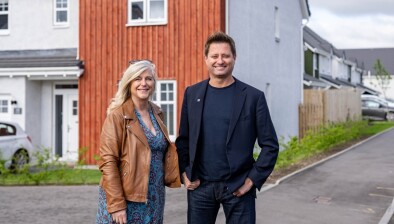Affordable housing programme ‘on target’ at halfway point
 The Scottish Government is on track to meet its target of delivering 50,000 affordable homes over the duration of this Parliament, according to statistics in two newly published reports.
The Scottish Government is on track to meet its target of delivering 50,000 affordable homes over the duration of this Parliament, according to statistics in two newly published reports.
Figures in the Housing Statistics Annual Key Trends report show an increase of 745 homes (4%) across all sectors, from 18,683 in 2016-17 to 19,428 in 2017-18. This is the fifth consecutive increase and the highest annual figure since 2008-09.
Housing association new builds increased by 382 homes (14%), local authority new builds increased by 381 homes (34%), and private-led new builds decreased by 325 homes (2%), whilst rehabilitations increased by 359 homes (60%) and net conversions decreased by 52 homes (7%).
Meanwhile statistics from the Housing Statistics for Scotland Quarterly Update report also show that affordable housing approvals total 11,926 homes to end June 2018, up 12% (1,252 homes) on the previous year. This includes increases affordable rent approvals (up by 59% or 951 homes), and affordable home ownership approvals (up by 31% or 580 homes), with a decrease in social rent approvals (down by 4% or 279 homes).

Housing minister Kevin Stewart said: “I am immensely proud that this government has now delivered more than 78,000 affordable homes since 2007.
“I am delighted that these figures show we are on track to deliver at least 50,000 affordable homes over this Parliament, including 35,000 for social rent. This is backed by more than £3 billion - the single biggest investment in, and delivery of, affordable housing since devolution and we are determined to see it benefit all parts of Scotland.
“Making sure everyone has a safe, warm and affordable home is central to this government’s drive for a fairer and more prosperous Scotland. That is why we are now starting work with the housing sector to consider how we are best able to deliver affordable homes after our current programme. This year’s Programme for Government included proposals to develop a vision for housing in 2040 - the first time we have taken a long-term approach to ensuring that Scotland has housing fit for the future.
“That’s vital if we are to ensure we meet the needs of people in the future and continue to deliver housing for the people of Scotland.”
The Scottish Greens said the housing statistics point to a worrying decrease in sheltered housing.
The Quarterly Housing Update shows the number of sheltered, very sheltered and medium dependency houses provided by councils has reduced from 23,108 in 2006 to 20,315 in 2018.
Andy Wightman, the Scottish Greens’ housing spokesperson, urged ministers to reverse a previous decision to ignore the advice of the Equality and Human Rights Commission and set an accessible homes target.
The Lothian MSP said: “The number of people in Scotland aged over 75 will increase by 27% over the next ten years and by 79% over the next 25 years. Over the last 12 years, the number of sheltered, very sheltered and medium dependency houses provided by local authorities has decreased by 12% whilst the availability of sheltered accommodation has plummeted by 17%.
“Earlier this year, the housing minister was criticised by the Equality and Human Rights Commission for rejecting the organisation’s guidance to create an accessible homes target. It is vital that such a target is set and is achieved.”
Representative body Homes for Scotland (HFS) welcomed the 3% increase in new house building for 2017-18 but highlighted a mixed picture in the detail of the figures, with 16% fewer (532) private sector-led homes completed in Q1 2018 compared with the same quarter in 2017.
With the private sector playing a key role in assisting the Scottish Government to meet its ambitious affordable housing targets, chief executive at Homes for Scotland, Nicola Barclay, said: “We are encouraged to note these latest statistics indicate a positive overall picture for affordable housing approvals as well as the wider sector. Whilst the extreme weather conditions earlier in the year made delivery challenging, it is essential that we are not complacent when it comes to our efforts to increase supply across all tenures.
“As well as enabling increased activity from smaller builders, sustained confidence from investors is essential to support growth from medium to larger builders within a competitive UK environment. It is also crucial that the labour market is geared up across the sector, with skills shortages already creating challenges on sites across Scotland.
“In addition to the above, the Planning (Scotland) Bill represents a key opportunity to recalibrate our planning system so it can deliver what the people of Scotland need: enough high-quality homes in the right places to meet need and demand. HFS is working hard to persuade politicians and communities that a good system is one in which we collaborate effectively in order that precious time, resource and funds can be channelled into the development of vibrant places and the delivery of more homes.”
 Key findings from the Annual Housing statistics update:
Key findings from the Annual Housing statistics update:
New housing supply: New housing supply (new build, refurbishment and net conversions) increased by 4% between 2016-17 and 2017-18, from 18,683 to 19,428 new homes.
Housing supply figures include private-led and social sector new builds, as well as conversions and rehabilitations. Housing association new builds increased by 382 homes (14%), local authority new builds increased by 381 homes (34%), and private-led new builds decreased by 325 homes (2%), whilst rehabilitations increased by 359 homes (60%) and net conversions decreased by 52 homes (7%).
New house building: In 2017-18, 17,731 new build homes were completed in Scotland, an increase of 438 homes (3%) on the 17,293 completions in the previous year, the fifth consecutive annual increase and the highest annual number of completions since 2008-09. During the same time-period the number of homes started decreased by 129 homes (1%) from 19,724 to 19,595. Housing association approvals fell by 235 homes (5%), and local authority starts dropped slightly by 13 homes (1%), whilst private-led starts increased by 119 homes (1%).
Affordable housing: (As previously reported on 12th June 2018): In 2017-18, there were 8,534 units completed through all Affordable Housing Supply Programme (AHSP) activity, an increase of 1,198 units (16%) on the previous year. Approvals increased by 1,401 units (14%) in the latest year to reach 11,677 in 2017-18, and starts increased by 1,261 units (14%) to reach 10,569. This activity represents the first two years in the target period to build 50,000 affordable homes, including 35,000 for social rent, over the five year period from 2016-17 to 2020-21.
Local authority housing stock: At 31st March 2018, there were 314,482 local authority dwellings in Scotland, a slight decrease of 334 units (0.1%) from the previous year.
Vacant stock: Local authorities reported 7,140 units of vacant stock at 31st March 2018, 976 units (16%) more than the 6,164 vacant units in the previous year, driven by increases in units awaiting demolition (an increase of 503 units), units part of a modernisation programme (an increase of 310 units), and vacant normal letting stock (an increase of 319 units). Vacant units used as temporary accommodation for the homeless fell by 7, and vacant units in low demand areas fell by 149 units..
Lettings: During 2017-18 there were 25,666 permanent lettings made, a slight decrease of 122 units (0.5%) compared to 25,788 lettings in the previous year. There were 10,805 lets to homeless households in 2017-18, which equates to 42% of all permanent lets by local authorities.
Evictions: Eviction actions against local authority tenants resulted in 1,460 evictions or abandoned dwellings in 2017-18 (1,023 evictions, 437 abandoned dwellings). This is up by 3%, or 39 actions of evictions or abandonments, on the 1,421 in the previous year.
Housing Lists: Household applications held on local authority or common housing register lists decreased by 3% or 4,346 households to 157,806 at March 2018, the tenth consecutive annual decrease.
Scheme of assistance: There were 9,049 scheme of assistance grants paid to householders in 2017-18, 1,434 grants (14%) fewer than in 2016-17. Spend on scheme of assistance grants totalled £29.8 million, around £2 million less than in 2016-17. The majority of grants in 2017-18 were for disabled adaptions; 5,599 grants totalling £21.9 million.
Houses in multiple occupation: In 2017-18, 9,025 applications were received in respect of the mandatory licensing scheme for houses in multiple occupation (including new applications and applications for renewal). At 31st March 2018 there were 15,671 licences in force, representing an increase of 2% over the previous year.
Key findings from the Quarterly Housing statistics update:
New Build Housing - All Sectors - up to end March 2018
New Build Housing - Private-led Housing - up to end March 2018
New Build Housing - Social Sector Housing (Housing Association and Local Authority combined) - up to end March 2018
Between April and June 2018, 934 social sector homes were completed (7% more than the 875 completions in the same quarter in 2017), and 1,158 were started (90% more than the same quarter in the previous year). This brings the total completions for the 12 months to end June 2018 to 4,688 (a 25% increase on the 3,764 social sector homes completed in the previous year). Total starts over the 12 months to end June 2018 are now at 6,617 (6% more than the 6,255 started in the previous year).
New Build Housing - Housing Association Homes - up to end March 2018
















